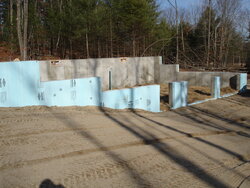To all of you that have your wood stove sitting on a conrete floor in an unfinished basement, I need some advice on insulating my basement floor.
I noticed that my wood stove is doing a pretty good job of heating up the concrete in my basement. My stove is a Jotul F55 and for now it sits directly on the concrete floor (I will likely build a hearth pad out of tile under the stove next summer). I think that the heat the floor receives is primarily through conduction - in other words heat coming from the stove legs in direct contact with the concrete. The plan is to start finishing the basement and I am debating on whether or not to put a layer of rigid foam down on the floor before I put something else on top (likely laminate or vinyl). I'm 99% sure there is no insulation under my slab, so in theory I am losing heat to the ground. However, I am concerned that if I put insulation on top, then the heat from the stove won't make its way around as easily since the heat in the floor won't be able to make it through the insulation. I know conventional wisdom probalby says I will gain more than I lose by insulating the floor, but what say you? Anyone out there have some real life experience with a similar situation?
I noticed that my wood stove is doing a pretty good job of heating up the concrete in my basement. My stove is a Jotul F55 and for now it sits directly on the concrete floor (I will likely build a hearth pad out of tile under the stove next summer). I think that the heat the floor receives is primarily through conduction - in other words heat coming from the stove legs in direct contact with the concrete. The plan is to start finishing the basement and I am debating on whether or not to put a layer of rigid foam down on the floor before I put something else on top (likely laminate or vinyl). I'm 99% sure there is no insulation under my slab, so in theory I am losing heat to the ground. However, I am concerned that if I put insulation on top, then the heat from the stove won't make its way around as easily since the heat in the floor won't be able to make it through the insulation. I know conventional wisdom probalby says I will gain more than I lose by insulating the floor, but what say you? Anyone out there have some real life experience with a similar situation?


